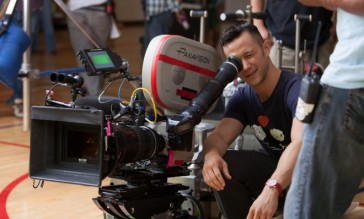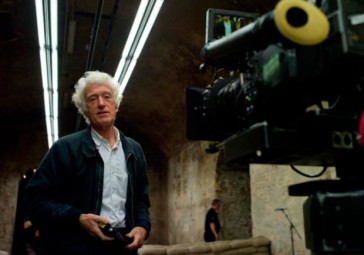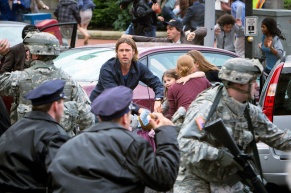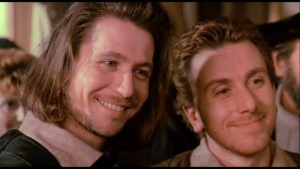11 December, 2013
 Mark and Jay Duplass exhibit the mundane elements of everyday life with The Puffy Chair, a road-trip film that explores these banalities as its self-centered characters go on a journey yet essentially do nothing extraordinary except watch television and disagree with each other. This quasi-documentary glimpse into the triteness of life utilizes naturalism and a low-budget style that diverges from conventional Hollywood filmmaking. The Duplass brothers satirize interpersonal issues when blurring the lines between their real and fictional relationships, with family members and significant others playing parts alongside Mark Duplass in this independent film. With breakdowns in communication, the duo mocks the quickness of romantic relationships in Hollywood films, questioning viewer’s acceptance for this hyper-compressed construction of time. Through presenting failures in communication as an antithesis to Hollywood conventions, The Duplass brothers’ mumblecore film anticlimactically and naturalistically shows the disintegration of romantic relationships.
Mark and Jay Duplass exhibit the mundane elements of everyday life with The Puffy Chair, a road-trip film that explores these banalities as its self-centered characters go on a journey yet essentially do nothing extraordinary except watch television and disagree with each other. This quasi-documentary glimpse into the triteness of life utilizes naturalism and a low-budget style that diverges from conventional Hollywood filmmaking. The Duplass brothers satirize interpersonal issues when blurring the lines between their real and fictional relationships, with family members and significant others playing parts alongside Mark Duplass in this independent film. With breakdowns in communication, the duo mocks the quickness of romantic relationships in Hollywood films, questioning viewer’s acceptance for this hyper-compressed construction of time. Through presenting failures in communication as an antithesis to Hollywood conventions, The Duplass brothers’ mumblecore film anticlimactically and naturalistically shows the disintegration of romantic relationships.
With the approach toward naturalism, the camera often spins around in search of the action rather than knowing where the next moment takes place. Comparable to Dogma 95 films, no shots exist without the shakiness of the digital camera recording the action like a home video. Minimal sets and no special lighting also become evident, enhancing the sense of real life similar to other independent films of the 2000s like Half Nelson. In doing so, the Duplass brothers look at relationships through the comedy and entertainment that comes from moment-based, dysfunctional scenarios rather than life-altering, climactic events. Regarding relationships of even unlikable characters, this brings viewers a more genuine identification that Hollywood films cannot re-create without this unpredictable, home-video style.
Rhett and Amber’s relationship comes without much build-up. The film stops following them in what seems like an eventful day after they meet. Instead, it stays with Joel and Emily in all their dullness, watching television and talking. This does not further the plot other than exhibiting the unexceptional happenings of everyday life, not letting the film skip over any of these mundane activities in pursuit of something more interesting somewhere else. Viewers only see the promise of Rhett and Amber’s first encounter, yet the suddenness of their marriage forces the audience into dooming the relationship rather than interpreting it as a hopeful scenario. Joel also acknowledges the ridiculousness of the situation, yet he allows for suspending his disbelief during the surprise engagement party that escalates into becoming a wedding.
The Puffy Chair’s strength as an independent rather than big-budget, studio film comes from its improvisational style. This quality occurs not only with performances, but also with the cinematography. A camcorder aesthetic gives an impromptu sense of unscripted urgency when the camera, often refocusing and providing extreme close-up, gives viewers an intimacy with the characters while maintaining an atmosphere of movement and spontaneity. Though reliant on this spontaneity, this wedding scene makes an overt effort at scripting lines when Rhett repeats his wedding vows after what Joel dictates. Still, unlike the performances for typical, Hollywood films, Rhett cannot say the lines verbatim even within moments of Joel’s dictation. In this scene, Rhett also makes minor alterations to his brother’s words, exemplifying the immediate disconnect between the way the characters communicate in the film as well as Rhett’s incapability in promising commitment to Amber.
This scene also makes an anticlimactic parody of the fast-paced romances in Hollywood films; Rhett meets his wife and ends their relationship within a day. In her article, “Against Hollywood: American Independent Film as a Critical Cultural Movement,” Sherry B. Ortner says, “Where Hollywood films seek to provide escape and fantasy, independent films seek to tell realist or hyper(bolic)-realist stories about the world as it really is, in all its ugliness and cruelty, or all its weirdness and strangeness…” (Ortner 10-12). Ortner describes how Hollywood idealizes situations in a way unlike independent films. Emily, Joel’s girlfriend who deludes herself with romanticizing relationships, falls into this Hollywood mentality that separates her from Joel.
Emily spends her free time watching movies and hoping for pop-culture reenactments, like Joel holding speakers outside her window. These moments also show that other films exist as fictions and entertainment for parodies within the world of this Duplass brother’s mumblecore. In creating these Hollywood ideals, Emily convinces herself of the possibilities for an unrealistic, happy ending for Rhett and Amber even though the relationship disintegrates as fast as it ignited. Even the eBay-bought chair, which Rhett believes taints their group relationship, meets an anticlimactic end. Rhett lights it on fire and within that minute, a stranger extinguishes it, putting out the flames to a potentially dramatic instance without letting the moment build up.
The moment becomes prosaic in the same way Emily and Joel’s relationship dissolves without a grand payoff. In the opening scene, when Emily and Joel fight and she storms off, this dramatic occurrence fizzles when Joel walks back inside his house instead of chasing after her. Later in the film, Joel says, “There’s a lot of things in this world we pursue that seem really important to us and we get wrapped up in.” In a Hollywood film, one attributes this pursuit to winning over the significant other. In this film, Joel fights harder for the trivial upholstering of an unappealing chair than for his relationship.
The final scene also removes itself from Hollywood conventions by rejecting the happy ending. As Ortner writes, “…Hollywood films are in the business of fantasy and illusion, independent films… are usually highly realist; and finally, where Hollywood films classically have happy endings, independent films rarely do” (2). Here in the film’s final moments, Joel and Emily break up. While they argue with each other throughout the film, no big fight occurs within their splitting up. They make an amicable departure to their relationship, hugging each other for closure to a relationship they leave behind. Dissimilarly, Hollywood films prefer the happy, boy-gets-the-girl endings or scenes of aftermath in showing how characters cope with the break ups, like with He’s Just Not That Into You’s network narrative exemplifying each of these scenarios.
The Puffy Chair provides neither of those alternatives. Instead, it opts for authenticity, especially with Mark Duplass and Katie Aselton being a couple while playing the parts of two people in a relationship. In addition, the non-actor parents of Mark and Jay Duplass play Joel and Rhett’s parents in the film. By doing so, The Puffy Chair creates an overlap between real life and the fictitious plot of the film by blending actors and characters. This authenticity and naturalism gives viewers the impression of watching what happens in the real world rather than an upbeat ending one hopes for in a conventional, Hollywood comedy. If Hollywood films sugarcoat or sweep away the harsh realities of opposites attracting in relationships or sudden romance, independent films such as The Puffy Chair use tough love for reminding viewers of the problems present in these scenarios.
Unlike Hollywood films, The Puffy Chair approaches break-ups as the result of rushed relationships where characters lack commitment. The lack of communication between Emily and Joel exemplifies two people with different agendas. She wants marriage while he confronts her for unrealistic expectations of him. They stay together until the randomness of life happens on a road trip where they learn their differences, break up, and implicitly move on. The Duplass brothers mimic the naturalness of real-life disagreements, like neorealist films do in presenting the everyman and using non-professional actors for authenticity, instead of giving viewers an escape into the excitement of studio-concocted productions about finding everlasting love. In a way, The Puffy Chair even makes a joke of seeking excitement from Hollywood cinema when Rhett says, “So we pretty much have the whole day to do nothing,” which they do, so they go see a movie.
Works Cited
Half Nelson. Dir. Ryan Fleck. Screenplay by Ryan Fleck and Anna Boden. Perf. Ryan Gosling. Thinkfilm and Hunting Lane Films Present, 2006. DVD.
He’s Just Not That Into You. Dir. Ken Kwapis. Screenplay by Abby Kohn and Mark Silverstein. Prod. Drew Barrymore. Perf. Justin Long, Jennifer Aniston, Ben Affleck, and Bradley Cooper. Warner Bros., 2009. DVD.
Ortner, Sherry B. “Against Hollywood: American Independent Film as a Critical Cultural Movement.” HAU: Journal of Ethnographic Theory 2.2 (2012): 1-21. HAU Journal. Web. 6 Dec. 2013.
The Puffy Chair. Dir. Jay Duplass and Mark Duplass. Screenplay by Mark Duplass and Jay Duplass. Perf. Mark Duplass, Katie Aselton, and Rhett Wilkins. Roadside Attractions, 2005. DVD.
































